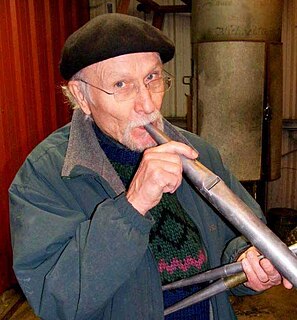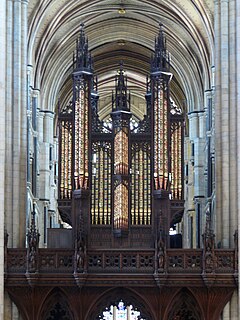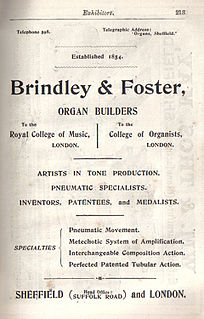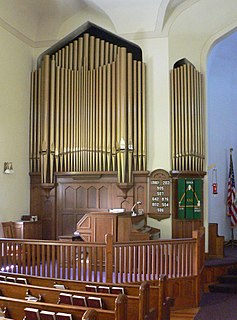Related Research Articles

Speyer is a city in Rhineland-Palatinate in Germany with approximately 50,000 inhabitants. Located on the left bank of the river Rhine, Speyer lies 25 km south of Ludwigshafen and Mannheim, and 21 km south-west of Heidelberg. Founded by the Romans, it is one of Germany's oldest cities. Speyer Cathedral, a number of other churches, and the Altpörtel dominate the Speyer landscape. In the cathedral, beneath the high altar, are the tombs of eight Holy Roman Emperors and German kings.

Æolian-Skinner Organ Company, Inc. of Boston, Massachusetts was an American builder of a large number of pipe organs from its inception as the Skinner Organ Company in 1901 until its closure in 1972. Key figures were Ernest M. Skinner (1866–1960), Arthur Hudson Marks (1875–1939), Joseph Silver Whiteford (1921-1978), and G. Donald Harrison (1889–1956). The company was formed from the merger of the Skinner Organ Company and the pipe organ division of the Æolian Company in 1932.

Roy Thomson Hall is a concert hall in Toronto, Ontario, Canada. Located downtown in the city's entertainment district, it is home to the Toronto Symphony Orchestra, the Toronto Mendelssohn Choir, and the Toronto Defiant. Opened in 1982, its circular architectural design exhibits a sloping and curvilinear glass exterior. It was designed by Canadian architects Arthur Erickson and Mathers and Haldenby. Itzhak Perlman acted as a special advisor to the architects on accessibility needs for disabled performers and guests.

Casavant Frères is a Canadian organ building company in Saint-Hyacinthe, Quebec, which has been building pipe organs since 1879. As of 2014, the company has produced more than 3,900 organs.

Ernest Martin Skinner was one of the most successful American pipe organ builders of the early 20th century. His electro-pneumatic switching systems advanced the technology of organ building in the first part of the 20th century.

John Burlin Brombaugh is an American pipe organ builder known for his historically oriented tracker action pipe organs.

Austin Organs, Inc., is a manufacturer of pipe organs based in Hartford, Connecticut. The company is one of the oldest continuously-operating organ manufacturers in the United States. The first instruments were built in 1893 with the Austin Patent Airchest, and many remain in fine playing condition to this day.
E. and G.G. Hook was a pipe organ designing and manufacturing company, located in Boston, Massachusetts, which operated from 1827 to 1935. It was started, and originally run, by brothers Elias and George Greenleaf Hook.

Pasi Organ Builders, based in Roy, WA, manufactures mechanical action organs and restores historic instruments. Martin Pasi received his first formal experience in organ building during a four-year apprenticeship with the Rieger Company in his native Austria. After working in Austria and in the United States, Pasi set up his own studio, Pasi Organ Builders, in 1990 in a former school building in Roy, Wash.

Paul Fritts is an American organ builder based in Tacoma, Washington who, following historical models, has created over thirty mechanical action instruments that have contributed to the revival of historically informed organ music. The Murdy organ at Basilica of the Sacred Heart in Notre Dame, Indiana is his largest Fritts instrument to date, with four manuals (keyboards) and 70 stops. Other recent Fritts instruments of note are located at the University of Notre Dame, Princeton Theological Seminary, and Pacific Lutheran University. The organ at PLU was the largest Fritts organ built before the organ in Columbus.
Orgues Létourneau Limitée of Saint-Hyacinthe, Quebec is a prominent Canadian builder and restorer of pipe organs. The company was founded in 1979 by Fernand Létourneau, who served as president, owner and artistic director of the firm until 2019. In 2019, Fernand Létourneau sold the company to a long-time employee, Dudley Oakes.

The Cathedral of the Holy Cross is the cathedral of the Roman Catholic Archdiocese of Boston and is the largest Roman Catholic church in New England.
Roosevelt Organ Works was an American manufacturer of pipe organs. It was founded by Hilborne Roosevelt (1849–1886) and his younger brother, Frank Roosevelt (1862–1895), in 1872. It operated in New York City, with branches in Baltimore and Philadelphia. The brothers built some of the largest organs in the United States during their career, and many today are still prized for their quality and tone. The company was in operation until 1893.
Pipe organs that are tuned in meantone temperament are very rare in North America. They are listed here, by type of temperament and sorted by date of construction. North America is defined here as Canada, the United States of America and Mexico. All instruments listed are playable but unplayable instruments may be added with a note.

John Snetzler was an organ builder of Swiss origin, who worked mostly in England. Born in Schaffhausen in 1710, he trained with the firm of Egedacher in Passau and came to London about 1741. When he retired in 1781, his business continued and ended up with Thomas Elliot. Snetzler died in Schaffhausen on 28 September 1785.

Brindley & Foster was a pipe organ builder based in Sheffield who flourished between 1854 and 1939.
Manuel J. Rosales, Jr., is an American organ builder whose instruments display a strong synthesis of romantic and contemporary styles. His workshop has built over 30 pipe organs with his notable output including collaborations on the instruments at Walt Disney Concert Hall and Rice University.

Hinners Organ Company was an American manufacturer of reed and pipe organs located in Pekin, Illinois. Established in 1879 by German-American John Hinners, the firm grew through several partners, becoming Hinners & Fink in 1881, Hinners & Albertsen in 1886, and Hinners Organ Company in 1902. In the 1920s Hinners established a subsidiary, the Illinois Organ Supply Company, which mass-produced parts for Hinners and other firms. Business declined in the 1930s due to the Great Depression, changing technology, and increasing competition. Hinners became a service company in 1936 and closed in 1942.

The Dreifaltigkeitskirche is a late Baroque, Protestant parish church in Speyer, Rhineland-Palatinate, Germany. Since 1988 it has been a cultural asset worthy of protection within the meaning of Article 1 of the Hague Convention for the Protection of Cultural Property in the Event of Armed Conflict.
References
- ↑ Bouchard, Antoine; Graham, Melva. "Kney, Gabriel". Encyclopedia of Music in Canada. Archived from the original on 2006-05-02. Retrieved 2008-04-19.
- ↑ "Organs in Ames Churches". Ames Historical Society. Archived from the original on 8 February 2012. Retrieved 2008-04-20.
- ↑ Blanton, Joseph E. (1957). The organ in church design. Albany Tx: Venture Press. p. 431.
- ↑ Komisaruk, Kevin (2005). "Gabriel Kney Pipe Organ, Opus 95, 1981". The Corporation of Massey Hall and Roy Thomson Hall. Retrieved 2008-04-19.[ permanent dead link ]
- ↑ "About the Cathedral's organ". Grace and Holy Trinity Cathedral. Archived from the original on 7 July 2011. Retrieved 2008-04-19.
- ↑ "Christ Church (Episcopal)". American Guild of Organists - Pensacola Chapter. Archived from the original on 4 March 2016. Retrieved 2008-04-20.
- ↑ "Gabriel Kney · Opus 105". University of St. Thomas. Archived from the original on 3 November 2013. Retrieved 2008-04-19.
- ↑ "1987 Kney organ at the University of St. Thomas, St. Paul, MN". American Public Media. Archived from the original on August 21, 2008. Retrieved 2008-04-19.